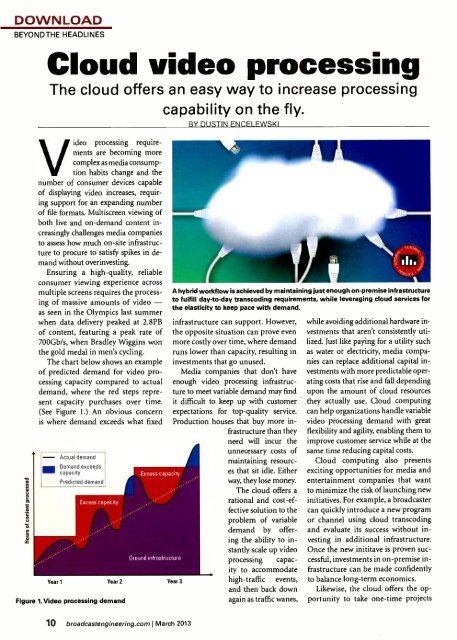ßroadcastEnsineerin - AmericanRadioHistory.Com
ßroadcastEnsineerin - AmericanRadioHistory.Com
ßroadcastEnsineerin - AmericanRadioHistory.Com
You also want an ePaper? Increase the reach of your titles
YUMPU automatically turns print PDFs into web optimized ePapers that Google loves.
DOWNLOAD<br />
BEYONDTHE HEADLINES<br />
Cloud video processing<br />
The cloud offers an easy way to increase processing<br />
capability on the fly.<br />
ideo processing requirements<br />
are becoming more<br />
complex as media consumption<br />
habits change and the<br />
number of consumer devices capable<br />
of displaying video increases, requiring<br />
support for an expanding number<br />
of file formats. Multiscreen viewing of<br />
both live and on- demand content increasingly<br />
challenges media companies<br />
to assess how much on -site infrastructure<br />
to procure to satisfy spikes in demand<br />
without overinvesting.<br />
Ensuring a high -quality, reliable<br />
consumer viewing experience across<br />
multiple screens requires the processing<br />
of massive amounts of video -<br />
as seen in the Olympics last summer<br />
when data delivery peaked at 2.8PB<br />
of content, featuring a peak rate of<br />
700Gb /s, when Bradley Wiggins won<br />
the gold medal in men's cycling.<br />
The chart below shows an example<br />
of predicted demand for video processing<br />
capacity compared to actual<br />
demand, where the red steps represent<br />
capacity purchases over time.<br />
(See Figure 1.) An obvious concern<br />
is where demand exceeds what fixed<br />
Actual demand<br />
Demand exceeds<br />
Elm capacity<br />
Predicted demand<br />
Year 1 Year 2<br />
Figure 1. Video processing demand<br />
BY DUSTIN ENCELEWSKI<br />
A hybrid workflow is achieved by maintaining just enough on- premise infrastructure<br />
to fulfill day -to -day transcoding requirements, while leveraging cloud services for<br />
the elasticity to keep pace with demand.<br />
infrastructure can support. However,<br />
the opposite situation can prove even<br />
more costly over time, where demand<br />
runs lower than capacity, resulting in<br />
investments that go unused.<br />
Media companies that don't have<br />
enough video processing infrastructure<br />
to meet variable demand may find<br />
it difficult to keep up with customer<br />
expectations for top -quality service.<br />
Production houses that buy more infrastructure<br />
than they<br />
need will incur the<br />
unnecessary costs of<br />
maintaining resources<br />
that sit idle. Either<br />
way, they lose money.<br />
The cloud offers a<br />
rational and cost -effective<br />
solution to the<br />
problem of variable<br />
demand by offering<br />
the ability to instantly<br />
scale up video<br />
processing capacity<br />
to accommodate<br />
high -traffic events,<br />
and then back down<br />
again as traffic wanes,<br />
Year 3<br />
while avoiding additional hardware investments<br />
that aren't consistently utilized.<br />
Just like paying for a utility such<br />
as water or electricity, media companies<br />
can replace additional capital investments<br />
with more predictable operating<br />
costs that rise and fall depending<br />
upon the amount of cloud resources<br />
they actually use. Cloud computing<br />
can help organizations handle variable<br />
video processing demand with great<br />
flexibility and agility, enabling them to<br />
improve customer service while at the<br />
same time reducing capital costs.<br />
Cloud computing also presents<br />
exciting opportunities for media and<br />
entertainment companies that want<br />
to minimize the risk of launching new<br />
initiatives. For example, a broadcaster<br />
can quickly introduce a new program<br />
or channel using cloud transcoding<br />
and evaluate its success without investing<br />
in additional infrastructure.<br />
Once the new inititave is proven successful,<br />
investments in on- premise infrastructure<br />
can be made confidently<br />
to balance long -term economics.<br />
Likewise, the cloud offers the opportunity<br />
to take one -time projects<br />
10 broadcastengineering.com I March 2013
















